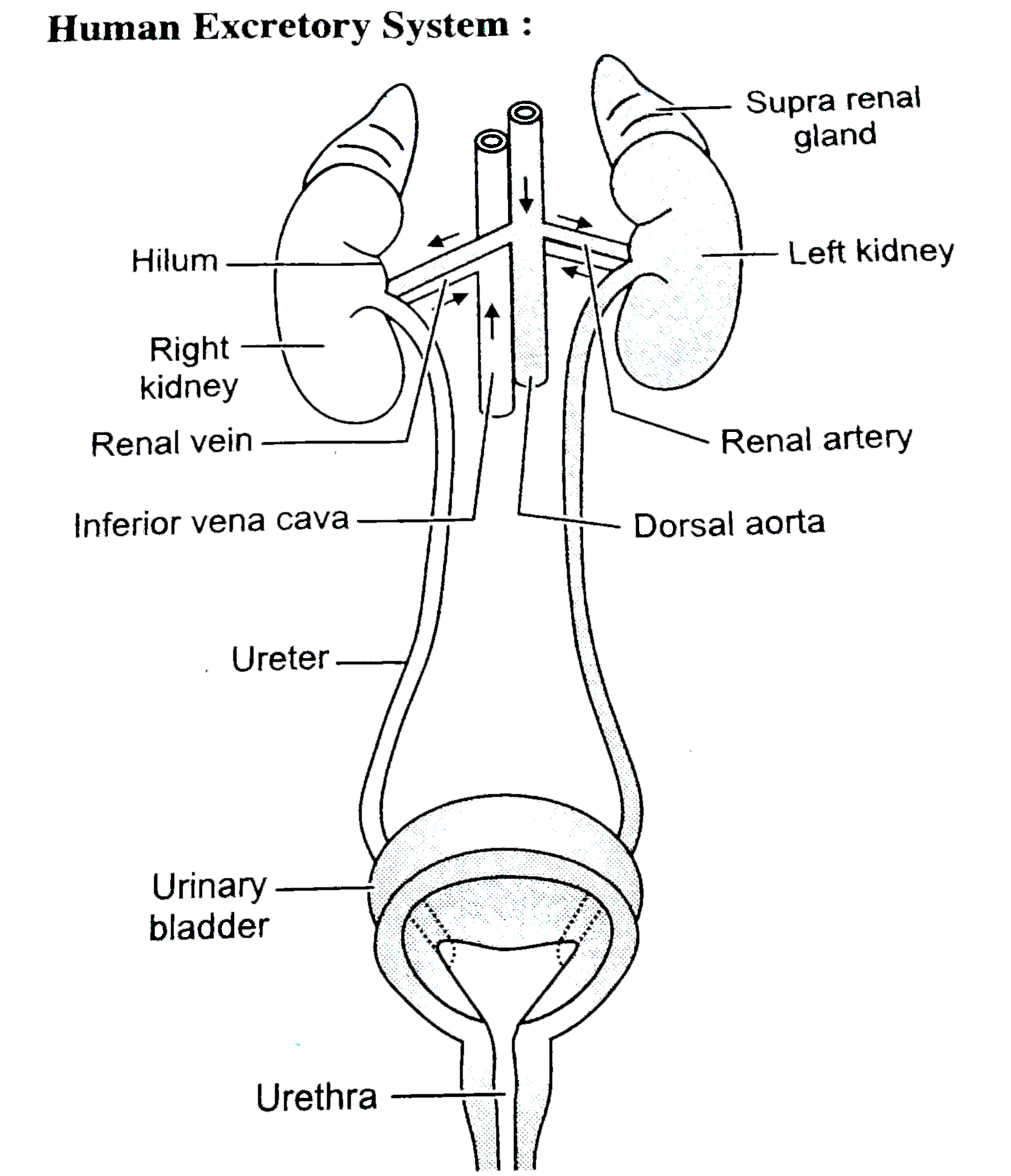Describe the structure of human excertory system with suitable diagram. Add a note on the process of urine formation.
Video Solution
Text Solution

Human excertory system.
(i) A pair of kidneys (ii) A pair of ureters
(iii) Urinary bladder .
(iv) Urethra in males or vestribule in females.
1. Kidneys : Dark red, bean-shaped, 10 cm long, 5 cm wide and 4 cm thick. Kidenys are attached to dorsal body wall to the level of 12 th thoracic to 3rd lumbar vertebra in the abdminal cavity. They are reptroperitoneal . Right kidney is slightly lower in position than left kidney.
2. Ureters : A pair of narrow ducts each coming out of kidney through the hilum and running particularaly up to urinary bladder. Each is about 40 cm long. They carry urine from kidneys to urinary bladder by peristaltic contractions.
3. Urinary bladder : Pear shapped structure having thick muscular wall lined by tansitional epithelium that allows expansion. It also shows thick layer of smooth muscle called detrusor muscule. It stores temporary urine.
4. Urethra : In females it is short 4 cm. In males it is longer i.e, 20 cm.
Mechanism of urine formation :
1. Ultrafiltration : It takes place in Malpighian body. It is a physical process glomerulus and Bowman's capsule act as filtering unit. Capillaries of glomerulus are extremely porous. Blood cells, plasma proteins and large fat molecules are unable to filter through capillaries. Due to difference in diamter of afferent and efferetn arteriole blood flows under high pressure about 99% of filtrate is reabsorbed and only 1-1.5 litres of urine is formed.
2. Selective reabsorption : About 99% of filtrate is reabsorbed. As filtrate moves through renal tubule, it comes in contact with blood found in peritubular capillaries. High threashold substances are completerly reabsorbed e.g, glucose and amino acid water is reabsorbed by osmosis in PCT. DCT and descending limb of loop of Henle.
PCT pumbs out glucose amino acids and ions like are absorbed by diffusion.
3. Tubular secretion : The tubular cells do nto synthesize any material and add to the filrtrate of urine. They only allow certain substances pass from blood to the lumen of the tubule. The substances that are routinely secreated are creatinine and potassium and hydrogen ion. THe secretion of hydrogen which takes place in DCT and collecting tubele is important for homeostatic regulation of acidity of blood.
Some abnormal substances found in the blood are also sereated in urine.
|
Topper's Solved these Questions
- JULY 2018Book:GURUKUL PUBLICATION - MAHARASHTRA PREVIOUS YEAR PAPERSChapter: JULY 2018Exercise:SECTION - II
Explore 24 Videos
- JULY 2017 Book:GURUKUL PUBLICATION - MAHARASHTRA PREVIOUS YEAR PAPERSChapter: JULY 2017 Exercise:Section-II ( ZOOLOGY)
Explore 24 Videos
- MARCH 2014Book:GURUKUL PUBLICATION - MAHARASHTRA PREVIOUS YEAR PAPERSChapter: MARCH 2014Exercise:SECTION - II (ZOOLOGY)
Explore 26 Videos
Similar Questions
Describe the structure of human excertory system with suitable diagram. Add a note on the process of urine formation.
View SolutionDescribe the structure of human heart.
View SolutionDescribe the structure of human heart.
View SolutionDescribe the structure of human stomach.
View SolutionDescribe the structure of human kidney.
View SolutionDescribe the structure of human kidney.
View SolutionDescribe the structure of human urinary system with diagram .
View SolutionDescribe internal structure of a human heart.
View SolutionDescribe internal structure of a human heart.
View SolutionDescribe the internal structure of human ear.
View Solution

